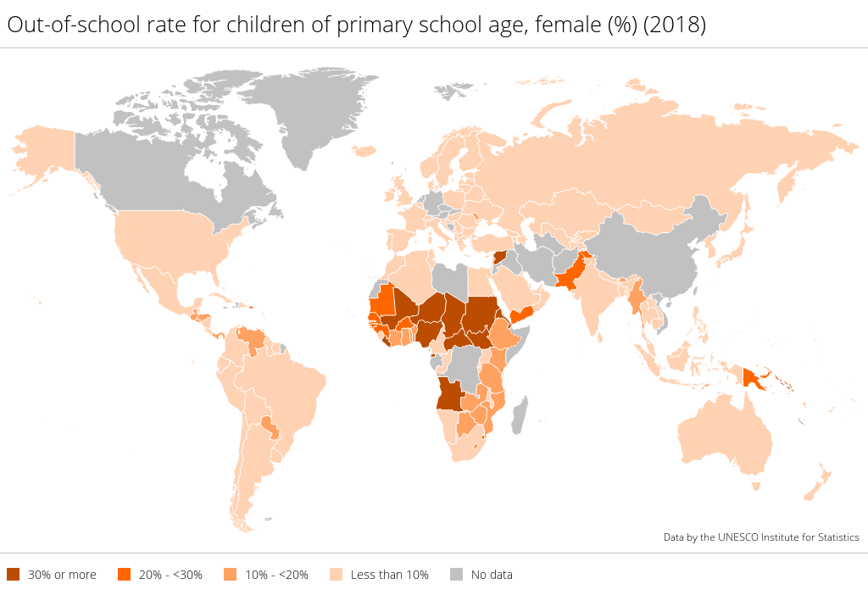Gender Inequality in Education
Understanding the connection between gender inequality and the lack of education opportunities can improve more sustainable development outcomes. Gender inequality cripples a nation’s economy at the expense of women. Policies and gender roles affect a nation’s education system by either not having a safe space for young girls to learn or not letting them have the opportunity of a quality education. According to UNESCO, an average of 130 million girls between the age of 6 and 17 are out of school and 15 million girls of primary-school age will never enter a classroom [1]. There is a huge gender gap in education around the globe which can be a result of many intersectional identities. The most common explanations for this gender gap are poverty, geographic remoteness, violence, disabilities, lack of infrastructure, or belonging to a minority ethno-linguistic group. The data ranges in different regions with the highest rates of gender inequality in education in Africa, South Asia, and the Middle East. We also see an increase in the out-of-school rates for females as the schooling progresses. Below are maps that include the percentages of young girls and women that are not in school. You can see how the percentages increase as the schooling level is increased.
Poverty and geographic remoteness are two of the biggest factors in the lack of education across the globe. Geographic remoteness can affect the eligibility of a child being able to receive an education or not. Children in rural locations may be hours away from a school. There are rural schools in some regions, but they normally lack a quality education. If there is no rural school, the child may travel hours away to attend a school. This involves problems of getting the child to school and the safety of the child traveling while their parents work. According to the World Bank, parents fear for the safety of their daughters to and from schools in Africa, South Asia and the Middle East. This can be an effect of sexual violence or harassment of young girls on public transportation [3]. A lot of developing countries have a lack of free education, which keeps its low-income citizens out of an education. This may be a result of the countries lack of income to be adequately resourced enough to provide quality education. A lack of free education creates a financial burden on families [2]. Lack of income affects both boys and girls, but there are other factors involved that keep more girls out of schools.
Gender based violence (GBV) is a main component in the gender gap in education. It can have a physical and emotional impact on victims and victim’s children. In Nicaragua, 63% of the children of abused women had to repeat a school year and dropped out of school on average four years earlier than others [2]. GBV can also include attacks on girls for accessing education. In 2012, Malala Yousafzai was shot in the face by members of the Taliban for promoting young girls to attend school [2]. GBV occurs on school grounds and can create an unsafe learning environment, which in return can create a high drop-out or low enrollment rate. It can be perpetrated by both teachers and other students. A 2010 survey in the Côte d’Ivoire found that 47% of teachers reported initiating sexual relations with students [2]. Examples of school related GBV also include bullying, harassment, and rape by fellow students. Some schools (including those in the U.S) have become a soliciting location for sex traffickers, which can include teachers and students. These GBV issues keep girls out of school by creating fear among young women and their parents.
Investing in secondary education is essential for equipping adolescent boys and girls with the knowledge and skills needed to become productive and engaged citizens. Advancing girls’ secondary education is one of the most transformative development plans countries can invest in. Completion of secondary education brings substantial benefits to girls and societies which includes, increased lifetime earnings to reductions in adolescent childbearing, child marriage, and maternal and child mortality [3]. Gender equality is crucial for ending poverty and boosting a nation’s economy. Better educated women tend to participate more in the formal labor market. This results in them earning higher incomes which leads to uplifting households, communities, and, ultimately, nations out of poverty [1].
Sources:
[1] https://www.worldbank.org/en/topic/girlseducation#1
[2] https://www.right-to-education.org/girlswomen
[3] https://data.unicef.org/topic/gender/gender-disparities-in-education/




